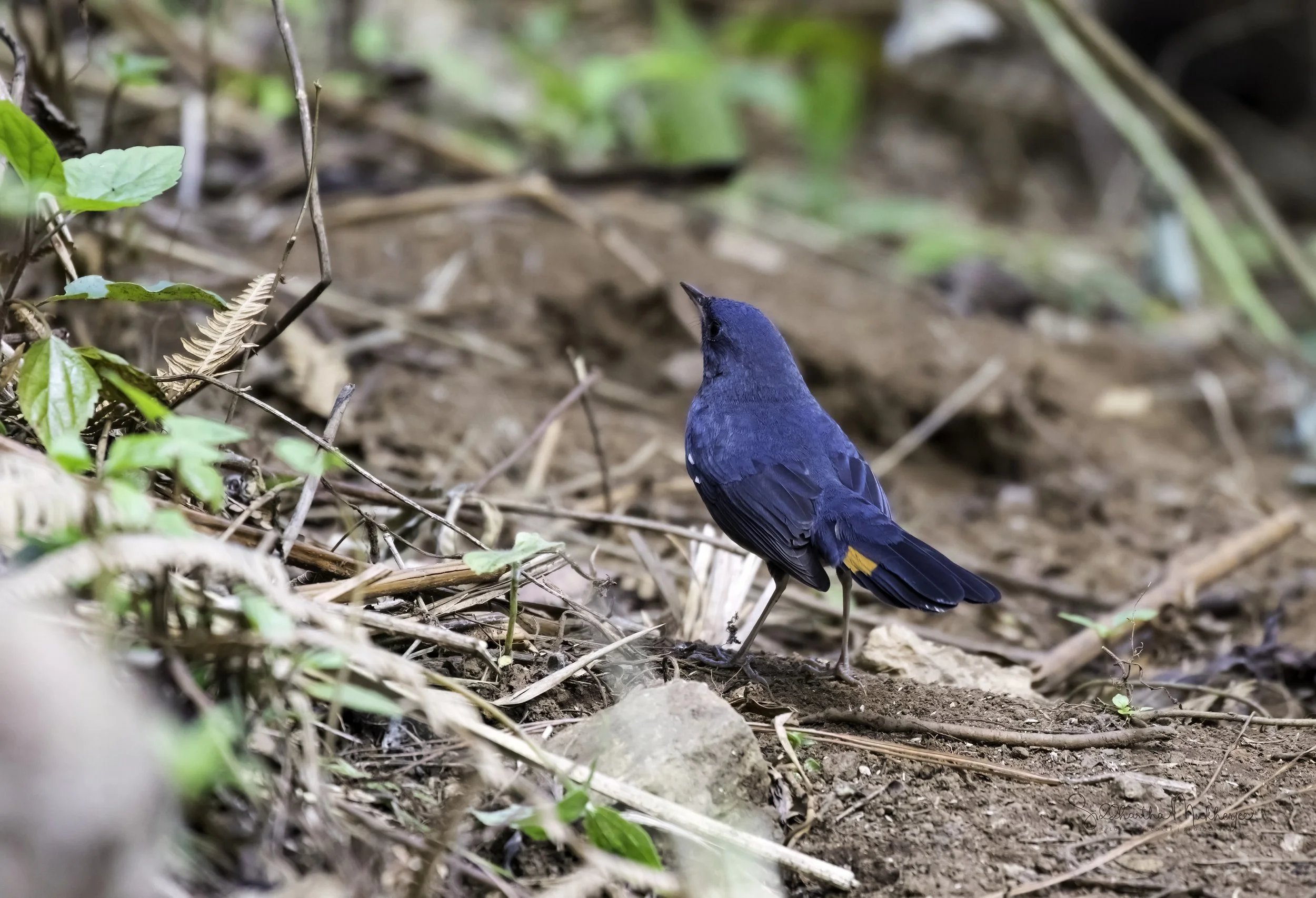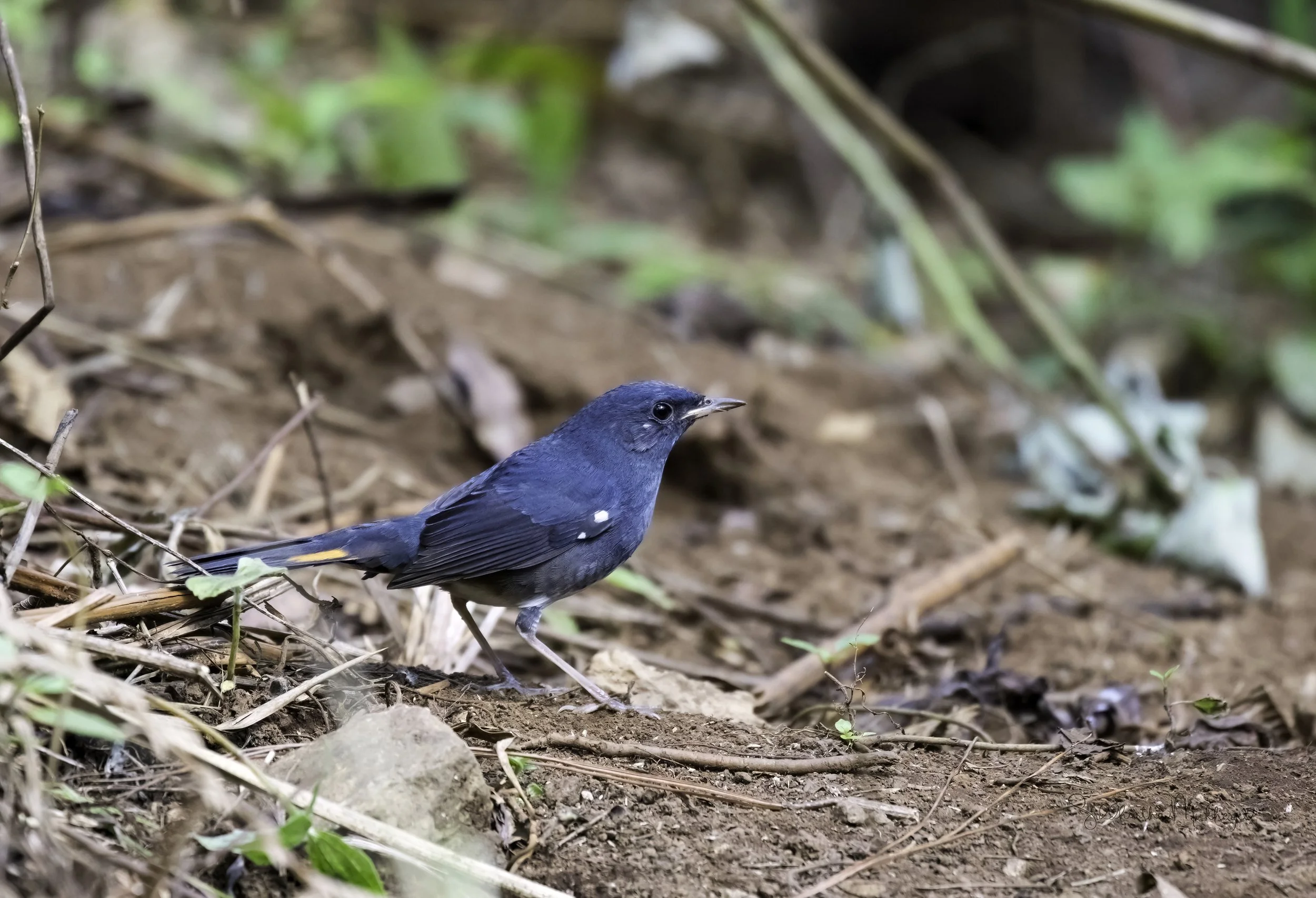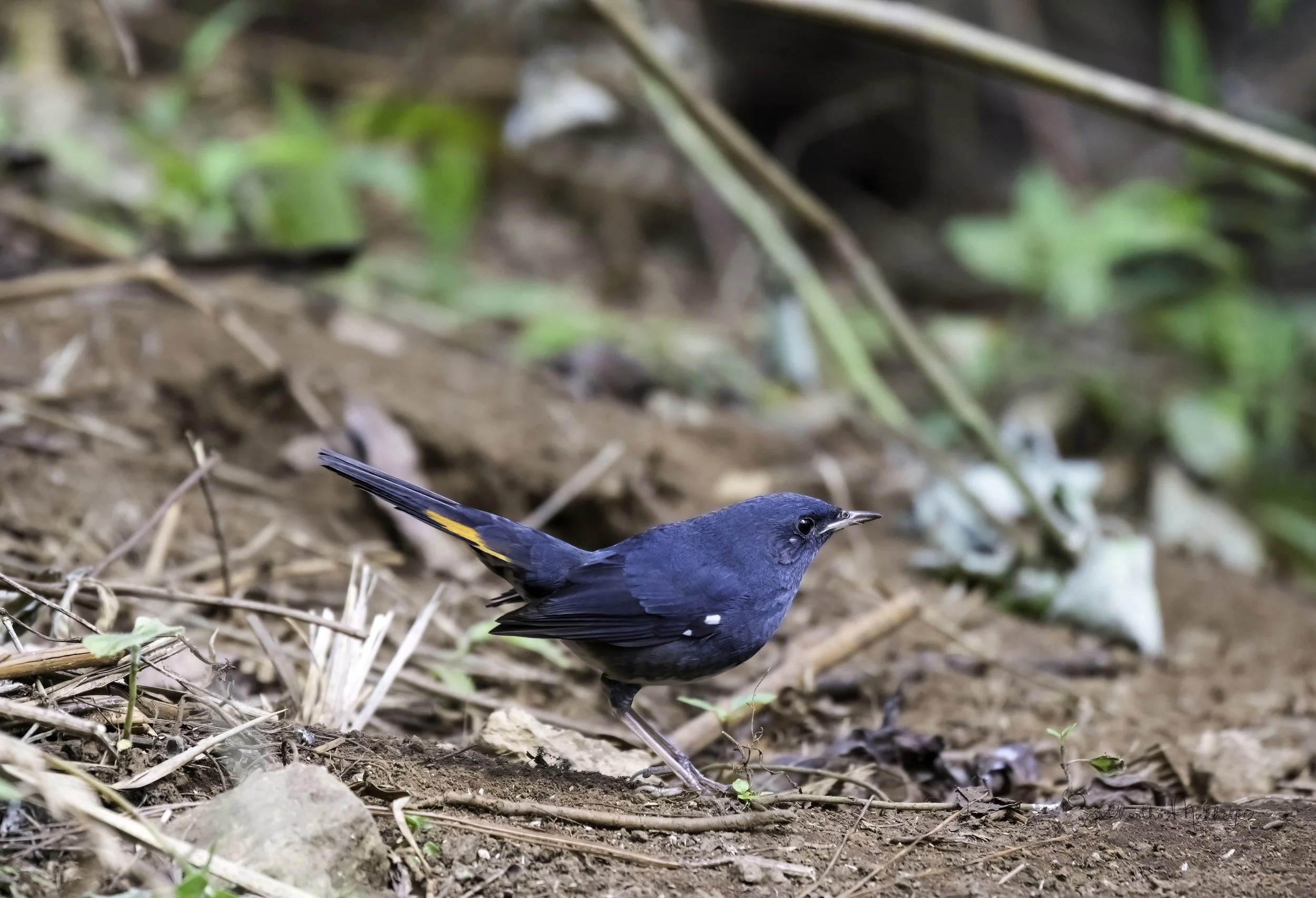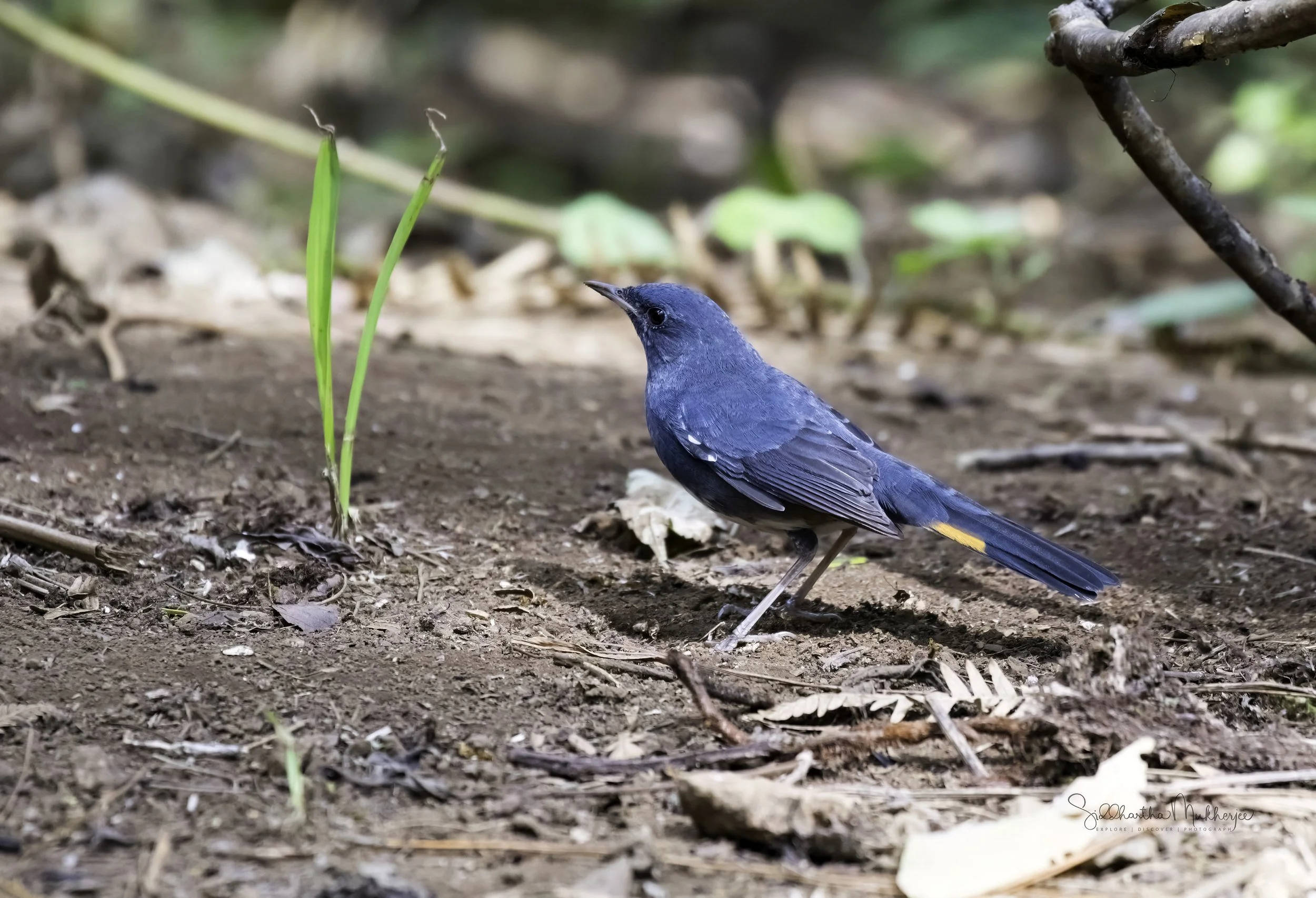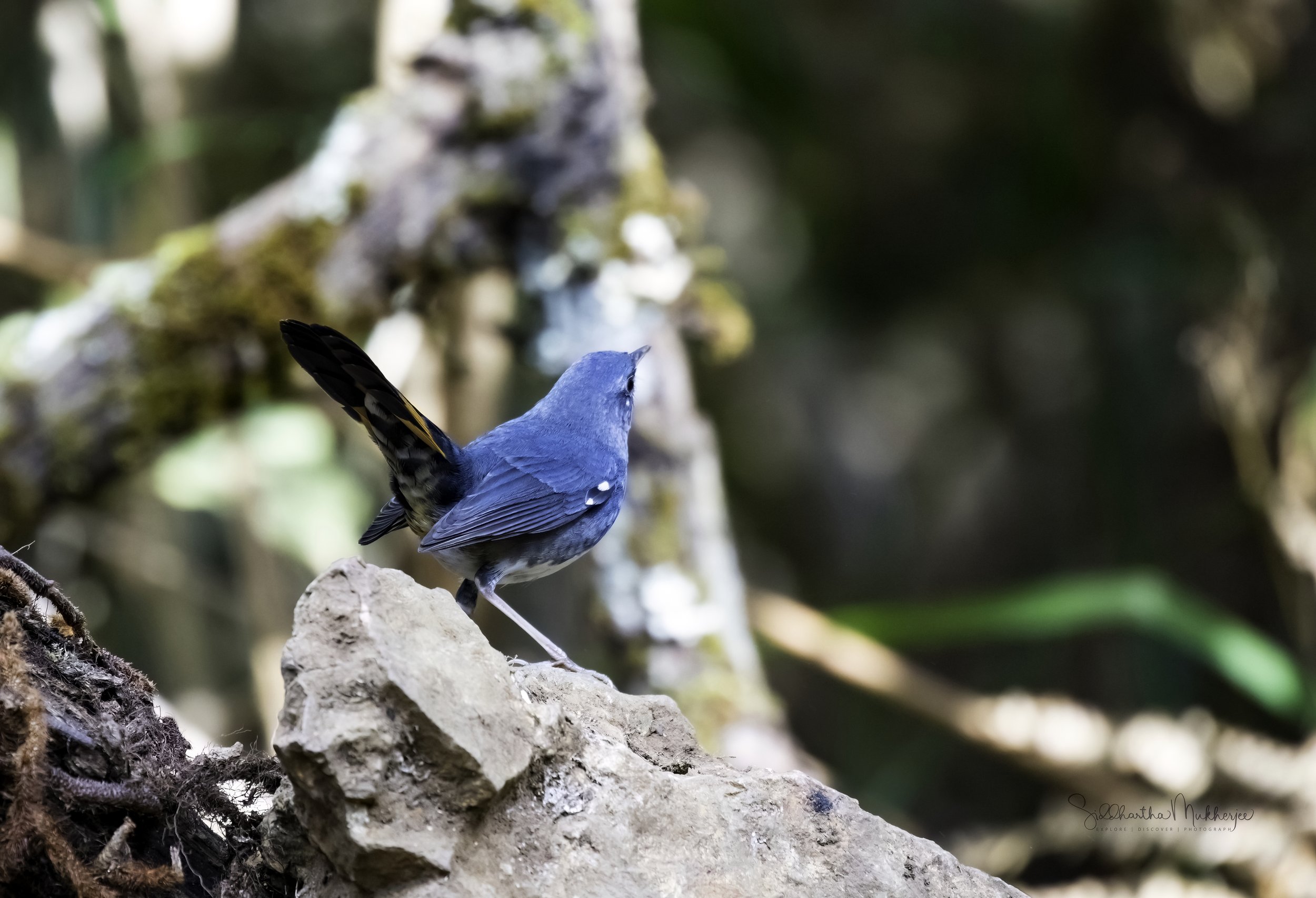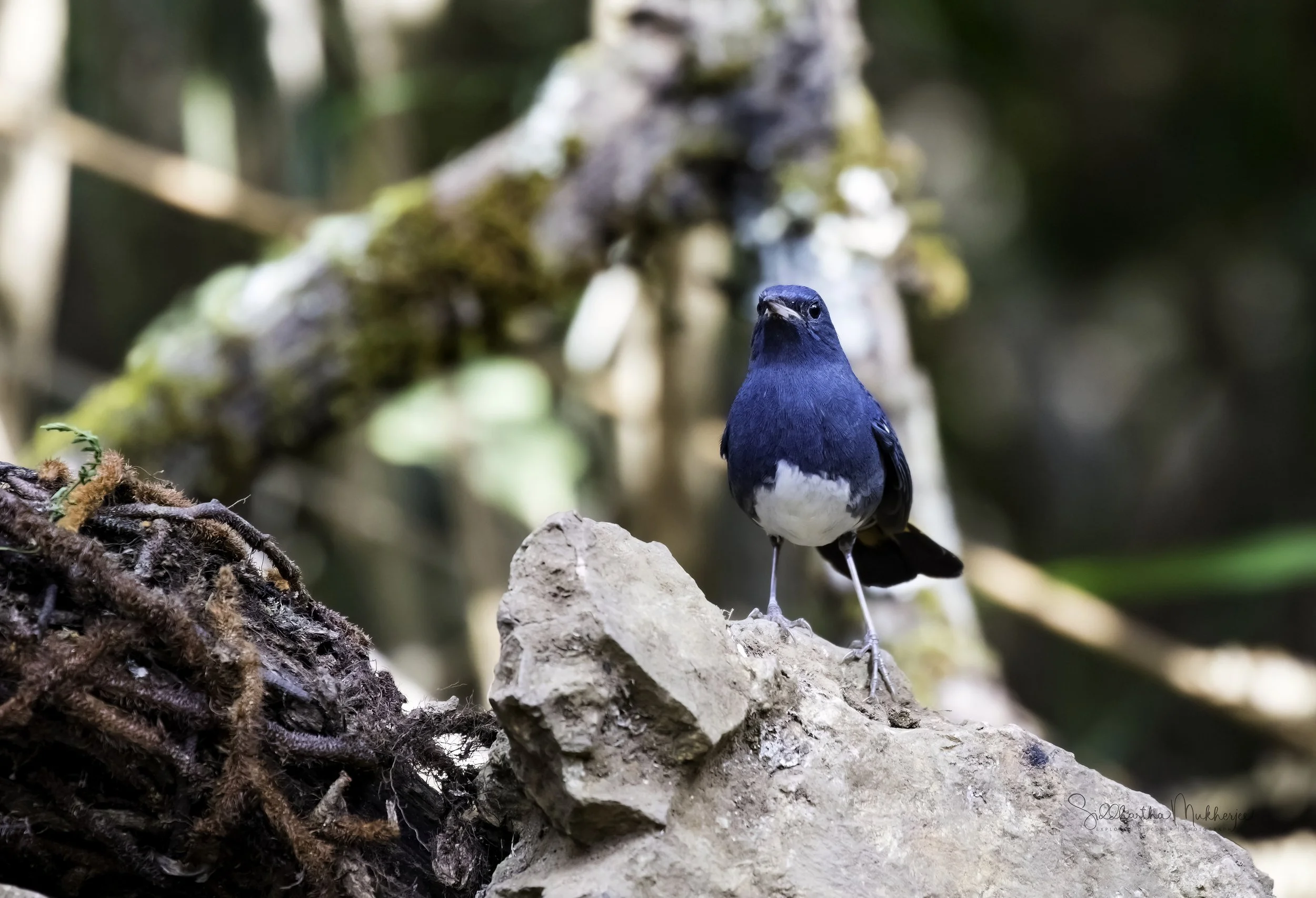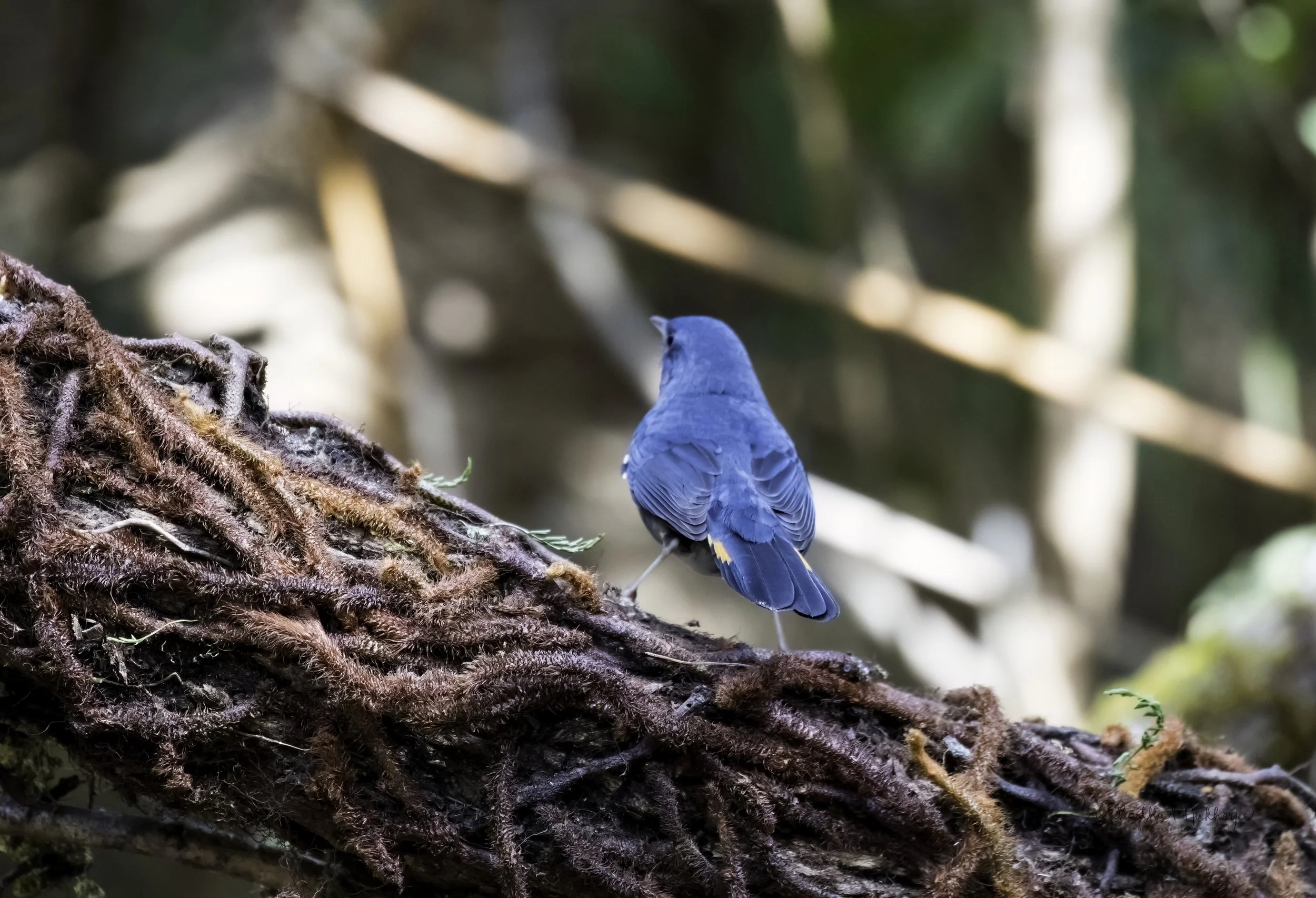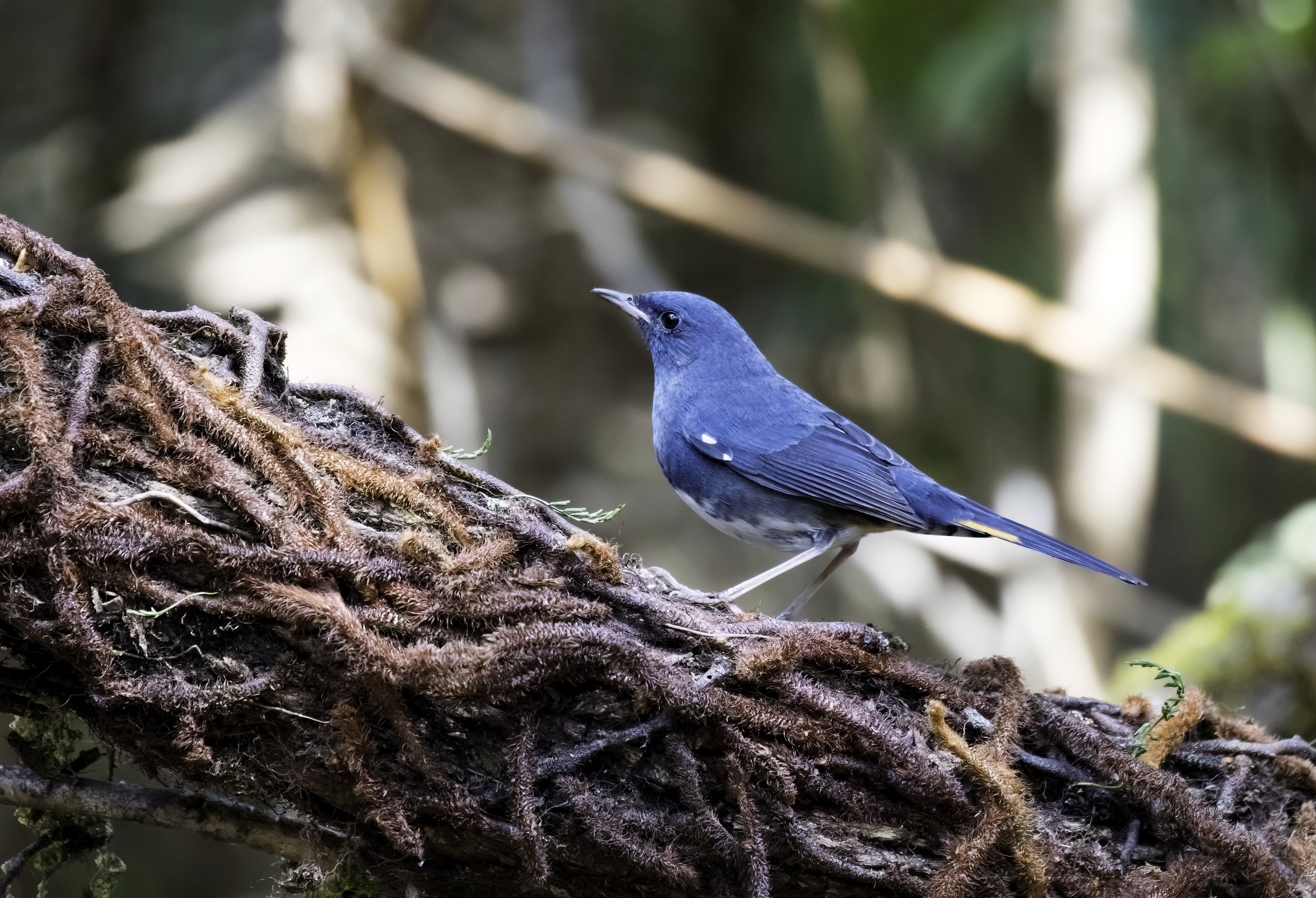White-bellied Redstart
Luscinia phaenicuroides
Chiang Mai, Thailand
It has been a while since I talked about the beautiful birds of Chiang Mai especially some spectacular ones up on Doi AngKhang. The White-bellied Redstart is a dark, medium-sized songbird species of bird of the family Muscicapidae with a long orange-sided tail, totally unlike any other redstart. It is found in Bhutan, China, India, Laos, Myanmar, Nepal, Pakistan, Thailand, and Vietnam, where its natural habitat is temperate forests. The white-bellied redstart was previously the only species in the genus Hodgsonius.
The White-bellied Redstart breeds in shrubby montane areas, particularly in the transition zone between forest and more open habitats and winters in similarly dense habitat at lower elevations. The male is predominantly grayish blue, with orange tail edges and a white belly while the female lacks the namesake white underparts and is instead brown overall with darker upperparts. Immature males have a blue head and chest, but are otherwise brown overall. Other redstarts in its range have a noticeably shorter-tailed profile. Song is an alternating series of clear, bell-like whistles and slurred whistles; most common call is a hard “tuktuk,” like stones knocking together.
The “Old World” - a fascinating term seemingly like something out of the Lord of the Rings and Jurassic Park put together. But in our case the term "Old World" is used commonly to refer to Asia, Africa and Europe (Afro-Eurasia or the World Island), regarded collectively as the part of the world known to its population before contact with the "New World" (the Americas). In the context of archaeology & world history, the term "Old World" includes those parts of the world which were in (indirect) cultural contact from the Bronze Age onwards, resulting in the parallel development of the early civilisations, mostly in the temperate zone between roughly the 45th and 25th parallels, in the area of the Mediterranean, Mesopotamia, Persian plateau, Indian subcontinent and China. The concept of the three continents in the Old World, viz. Asia, Africa, and Europe, goes back to classical antiquity. Their boundaries as defined by Ptolemy and other geographers of antiquity were drawn along the Nile in what is now Egypt and the Don river in Russia. This definition remained influential throughout the Middle Ages and the Early Modern period.
The Old World Flycatchers are a large family, the Muscicapidae, of small passerine birds mostly restricted to the Old World (Europe, Africa & Asia). These are mainly small arboreal insectivores, many of which, as the name implies, take their prey on the wing. The family includes 324 species & is divided into 51 genera. The name Muscicapa for the family was introduced by the Scottish naturalist John Fleming in 1822. The word had earlier been used for the genus Muscicapa by the French zoologist Mathurin Jacques Brisson in 1760. Muscicapa comes from the Latin musca meaning a fly and capere to catch. The appearance of these birds is very varied, but they mostly have weak songs and harsh calls. They are small to medium birds, ranging from 9 to 22 cm in length. Many species are a dull brown in colour, but the plumage of some can be much brighter, especially in the males. Most have broad, flattened bills suited to catching insects in flight, although the few ground-foraging species typically have finer bills. Old World flycatchers live in almost every environment with a suitable supply of trees, from dense forest to open scrub, & even the montane woodland of the Himalayas. The more northerly species migrate south in winter, ensuring a continuous diet of insects.
The family Muscicapidae contains many subfamilies and each sub family contains many tribes. I wrote about the genus Phoenicurus – Redstarts and the genus Myophonus - Whistling Thrushes in earlier blogs.
The Dois of northern Thailand have been very kind to me from a birding perspective. There are so many I have already talked about and so many still remaining. I have written an overview here on the Birds of the Dois and have now started to break them up into individuals like the Gray-backed Shrike, Long-tailed Shrike, Spectacled Barwing, Siberian Rubythroat, the stunning Mrs. Gould’s Sunbird and the numerous other birds I have seen here.
About 685 kilometers to the north of Bangkok lies the former seat of the ancient Lanna Kingdom and is considered one of the most scenic provinces in the country given its mountain ranges, valleys, flora and fauna. A land of misty mountains and colourful hill tribes, a playground for seasoned travellers, and a delight for adventurers. Despite its relatively small size and blissful calm, Chiang Mai truly has it all, a city that is still firmly Thai in its atmosphere and attitude. It is the second-largest changwat (province) of Thailand. Bordered by Chiang Rai to the northeast, Lampang & Lamphun to the south, Tak to the southwest, Mae Hong Son to the west and the Shan State of Myanmar to the north. Located in a verdant valley on the banks of the Ping River, Chiang Mai was founded in 1296 as the capital of the ancient Lanna Kingdom. Today it is a place where past and the present seamlessly merge with modern buildings standing side by side with venerable temples. Of all the places I have visited in Thailand, Chiang Mai with its forests and mountains and the historic city of Ayutthaya are by far my favourites.
The word Chiang itself is from North Thai, or Lanna, meaning town or city and Mai means new making Chiang Mai the New City as it was founded later than Chiang Rai, the earlier capital of King Meng Rai. The districts in the province are called amphoe, and sub-districts are called tambon. Another twist is the use of Nakhon (or Nakorn or Nakhorn), derived from the Sanskrit word Nagara, also means city, though strictly speaking it refers to a capital city such as Nakorn Sri Ayutthaya (more on Ayutthaya later). Indeed to emphasise its former status you may sometimes see Chiang Mai referred to as Nakhon Ping. Other common names of geographical features include mae (river) and doi which is north Thai for mountain - for example Doi Inthanon and Mae Ping.
The four Dois we spent our time on were Doi Inthanon, Doi Ang Khang, Doi Luang and Doi SanJu.
Doi Ankhang is a mountain belonging to the Himalayan foot hill range, located at the Myanmar (Burmese) border. The highest point is 1,928 metres. Although chiefly deforested, this is still one of Northern Thailand’s most prominent bird watching areas, due to more and rarer bird species being in residence, as well as being a popular resting point for numerous migratory birds. Examples of rare and beautiful birds inhabiting this area include the Mountain Bamboo Partridge, Spot-breasted Parrotbill, Tickell’s Leaf Warbler and the Red-faced Liocichla. It is not so uncommon to spot the Red-tailed Laughing Thrush here. Around The Royal Agricultural Project Station you can find Brown, Burmese and Long-tailed Shrike and also Fire-capped Tits and Silver-eared Mesia, White – tailed Robin & Maroon Oriole.
We didn’t have the good fortune to see all the species on all the mountains, that would have been impossible, but we did rack up quite a number of species - about 95 of them.
The beautiful road to the top of Doi Angkhang.
Read about the other birds from these beautiful mountains. These are only a few of the huge number I have spotted and recorded there.
With that said, meet this predominantly grayish blue redstart, with orange tail edges and a white belly from the mountains of Chiang Mai.
‡‡‡‡‡
White-bellied Redstart
The White-bellied Redstart (Luscinia phaenicuroides) is a captivating member of the Old World flycatcher family (Muscicapidae), renowned for its striking plumage and elusive nature. This small, vibrant bird offers a fascinating subject for ornithologists and photographers alike. For years, the white-bellied redstart (Luscinia phaenicuroides) was a ghost on my birding life list. A jewel of the Himalayas, known for its elusive nature and stunning slate-blue and white plumage. My quest to see one finally culminated in the misty mountains of Northern Thailand, but this bird’s true home spans a much wider, more rugged landscape that extends deep into India.
This is the story of that encounter, the life of this fascinating bird, and a guide for those hoping to photograph this mountain jewel on the Indian subcontinent.
The Encounter on Doi Ton Phung
The journey to observe the white-bellied redstart led to Doi Pha Hom Pok National Park in Chiang Mai, a prime location for high-altitude birding in Southeast Asia. A cold winter morning near the summit provided the right conditions. Mist filled the air, and the dense undergrowth along a mountain stream provided the ideal habitat. Armed with my 600mm, I observed from a respectful distance. Patience is key to observing this species. After waiting for an hour, a flash of movement and a quick chip call broke the silence. A male, approximately 15 centimeters long and weighing 15 grams, had landed on a mossy rock near the water's edge. Its rich, slate-blue head and back contrasted with a white belly. The bird constantly flicked its rufous-chestnut tail—a nervous habit that provided a stunning display. It foraged for insects, darting from the rock to the leaf litter before disappearing back into the thicket. A few images were captured before the bird vanished, a moment encapsulating the shy nature of this beautiful creature.
The white-bellied redstart is a small, compact passerine bird with notable sexual dimorphism in its plumage. The average length of the white-bellied redstart ranges from approximately 14 to 16 centimeters (about 5.5 to 6.3 inches). They typically weigh between 12 and 18 grams (about 0.4 to 0.6 ounces).
While the sighting was in Thailand, the white-bellied redstart is widespread across the Himalayas. It is an altitudinal migrant, meaning its presence in India changes with the seasons. During the summer breeding season, these birds are found high in the Himalayas, from Northern Pakistan across Kashmir, Himachal Pradesh, Uttarakhand, Nepal, and Bhutan, usually at elevations between 2,400 and 4,000 meters. They favor steep, vegetated ravines and the edges of evergreen forests where mountain streams run down the slopes. When winter arrives and snow covers their high-altitude breeding grounds, these birds migrate down to the foothills and the plains of Northern and Northeastern India. This is when they become more accessible to birders in states like Uttarakhand and West Bengal (around the Dooars region).
The male is distinctly marked and unmistakable. His plumage provides high contrast. The Upperparts are a deep, rich slate-blue or bluish-grey covers the crown, back, wings, and throat. This dark upper section contrasts sharply with a brilliant, clean white belly and undertail coverts. The tail is a vibrant rufous-chestnut color, a key feature often flicked or shivered when the bird is perched. Females are much duller and more cryptic in coloration, likely for camouflage while nesting. Overall they possess plain olive-brown upperparts and a paler, washed-out buffish-white underbelly, often appearing slightly mottled on the breast. The female retains the characteristic rufous tail, though the color is a duller chestnut compared to the male's vibrant version. Juvenile birds resemble females but have a more pronounced spotted or scaled pattern on their brown plumage, particularly on the chest and back, a common camouflage strategy for young birds.
The white-bellied redstart has a broad range across the Himalayas and Southeast Asia. It breeds primarily in the mountainous regions extending from northern Pakistan and India eastward through Nepal, Bhutan, Myanmar, and into southern China (Sichuan, Yunnan). During the winter months, the populations that breed at higher altitudes often descend to lower elevations or migrate south, spending the non-breeding season in the foothills and plains of Northern India, Bangladesh, Thailand, Laos, and Vietnam.
This species shows a preference for dense, damp habitats, often near water sources. During the breeding season, they favor high-altitude areas, typically between 2,400 and 4,000 meters (around 7,900–13,100 feet). Their ideal environment includes:
Dense Undergrowth: Thick scrub, bushes, and tangled vegetation along mountain streams and rivers.
Forest Edges: The periphery of evergreen or mixed forests.
Ravines: Steep, vegetated ravines and gullies.
In wintering grounds, they occupy similar environments at lower altitudes, such as riverine thickets, reedbeds, and damp clearings.
The white-bellied redstart is primarily an insectivore. Its diet consists largely of small invertebrates, including beetles, ants, flies, and caterpillars. They typically forage on or near the ground, often making short, quick darts from a low perch to snatch prey from the leaf litter or vegetation. This bird is generally shy, solitary, and somewhat elusive. They are typically difficult to observe for long periods in the dense undergrowth they inhabit. They are fast and agile, moving quickly between cover. A common behaviour is the frequent flicking or shivering of their distinctive chestnut tail, which helps in communication and species recognition. Their song is a melodic, complex series of fluty warbles and trills, often delivered from a hidden perch within a bush.
The white-bellied redstart is a classic altitudinal migrant and a partial seasonal migrant. The primary movement is vertical. Breeding populations in the high Himalayas descend to lower altitudes (foothills and plains) during the harsh winter months to find food and avoid cold. Some populations undertake longer southward migrations into Southeast Asia for the winter, returning to their breeding grounds in spring.
Photographing this shy bird requires patience, field craft, and a strong ethical approach to avoid disturbing the bird or its habitat. These birds are shy and easily disturbed.
Ethical Considerations
Prioritize the Bird's Welfare: Never flush a bird from a nest or force it into an exposed position for a better photo. The bird's well-being always comes first. If the redstart shows any signs of stress—alarm calls, movement away, or freezing in place—you are too close. Back off immediately. Never chase the bird for a better angle.
Choose the Right Location and Season especially in India: Target the lower Himalayan foothills during the winter months (November to March). They are often found near water bodies like the rivers in the Dooars region of West Bengal or specific river valleys in Uttarakhand.
Maintain Distance with a Long Lens and Natural Blinds: Use a telephoto lens (400mm or longer) to get frame-filling shots from a respectful distance. Avoid approaching too closely. The best approach is not to hunt for the bird, but to let the bird come to you. Find an area of suitable habitat (dense scrub by a river) and sit quietly, using natural cover like bushes or rocks as a makeshift blind.
Avoid Baiting or Luring: Do not use playback of calls or artificial feeders/lures to attract the bird. This disrupts natural behaviour and can expose the bird to predators.
Stay on Trails: Minimize habitat destruction by staying on established paths and trails.
Be Patient and Concealed: The best method is to sit quietly in an area where the bird is known to forage, perhaps near a mountain stream, and wait for it to appear naturally. Use natural blinds (bushes, rocks) for cover. Be prepared to wait for hours. They often appear for seconds and then disappear.
Avoid Unethical Practices: A common, but harmful, practice is using call playback to lure birds in. This disrupts their behavior and can expose them to predators. Never use artificial calls or bait to get a photo.
Technical Tips
Lighting: The dense habitats mean light can be low. Aim for early morning or late afternoon light for warm tones and potentially use a high ISO setting or a wide aperture lens.
Focus: Pre-focus on a likely perch or branch near where the bird has been active.
Shutter Speed: Use a fast shutter speed (1/500s or faster) to freeze the quick movements of this agile bird.
Capturing a white-bellied redstart on camera, whether in the moist thickets of Chiang Mai or the river valleys of the Indian Himalayas, is a memory that lasts a lifetime. It’s a pursuit that teaches patience, respect for nature, and the joy of a truly wild encounter. For me it was a very pleasant morning with a nice breeze and beautiful diffused light. The conditions were perfect for photography and gradually as we settled into our hides a number of birds came out to forage. Almost at the end of our session we were walking around trying to explore the area and the Redstart came out to play.
‡‡‡‡‡
Related Posts

